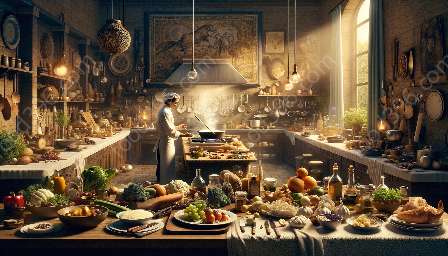The Renaissance period in Europe witnessed a remarkable evolution in cuisine, bringing together diverse flavors, ingredients, and culinary traditions. Delve into the vibrant world of Renaissance European cuisine, its historical significance, and its influence on the broader landscape of European cuisine history.
The Rise of Renaissance European Cuisine
The Renaissance, meaning 'rebirth,' marked a transformative era in European history, characterized by the revival of art, science, and culture. This resurgence also extended to the culinary realm, with new ingredients, cooking techniques, and flavors coming to the forefront.
Ingredients and Culinary Techniques
Renaissance European cuisine was a fusion of influences from across the continent, incorporating diverse ingredients such as seasonal vegetables, exotic spices, game meats, and freshwater fish. The emergence of trade routes and exploration brought new flavors from distant lands, enriching the culinary landscape.
Culinary techniques also experienced significant innovation during the Renaissance. Advances in food preservation, the use of open hearth cooking, and the refinement of pastry arts contributed to the development of a more sophisticated and varied European cuisine.
Cultural Influences
The culinary scene during the Renaissance was shaped by a convergence of cultural influences. The rise of city-states and the patronage of wealthy families and merchants led to the creation of lavish banquets and feasts. The interplay of art, music, and food gave rise to a multi-sensory culinary experience that reflected the spirit of the times.
Links to European Cuisine History
Renaissance European cuisine represents a key chapter in the broader history of European cuisine. It served as a bridge between the medieval culinary traditions and the culinary innovations that followed. The exchange of culinary practices between regions and the evolution of cooking styles laid the groundwork for the diverse culinary heritage seen across Europe today.
Culinary Evolution
The culinary evolution during the Renaissance laid the foundation for subsequent developments in European cuisine. It set the stage for the refinement of dining etiquette, the establishment of culinary guilds, and the codification of recipes and cooking methods. Renaissance European cuisine also contributed to the formation of distinct regional cuisines, each with its own unique identity and flavors.
Exploring Cuisine History
Understanding the evolution of Renaissance European cuisine requires an exploration of cuisine history at large. By tracing the historical, cultural, and economic factors that shaped the culinary landscape, one gains insight into the interconnectedness of food, society, and tradition. From the ancient civilizations to the modern culinary scene, cuisine history provides a fascinating narrative of human creativity and ingenuity.
Global Culinary Interactions
Cuisine history is a tapestry of global culinary interactions, reflecting the exchange of ingredients, cooking techniques, and culinary traditions across continents. It highlights the impact of colonization, trade routes, and cultural exchanges on the development of regional and global cuisines, illustrating the interconnected nature of culinary evolution.
Delving into cuisine history allows us to appreciate the symbiotic relationship between food and culture, and how culinary traditions have evolved over time, leaving an indelible mark on our collective gastronomic heritage.

